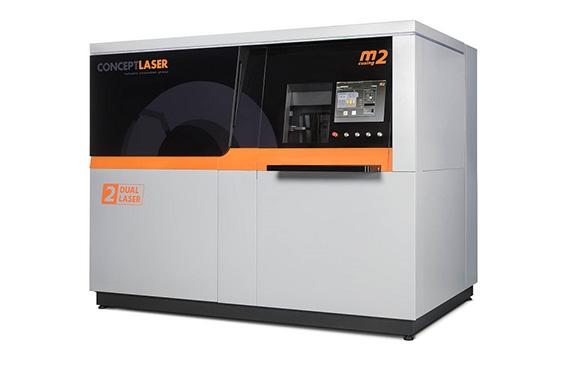 Concept Laser, one of the leading providers of machine and plant technology for 3D metal printing, is the newest member of a prestigious research and development consortium that’s dedicated to the creation and development of technologies that will speed up the certification and qualification of 3D printed metal parts. ADAPT, the Alliance for the Development of Additive Processing Technologies, is headquartered in Colorado, and was established in December of 2015, through a grant from the Colorado Office of Economic Development and International Trade (OEDIT) through their Advanced Industries. Concept Laser will bring a whole new level of expertise and understanding to ADAPT, as it is the first manufacturer of 3D metal printers to join the elite consortium.
Concept Laser, one of the leading providers of machine and plant technology for 3D metal printing, is the newest member of a prestigious research and development consortium that’s dedicated to the creation and development of technologies that will speed up the certification and qualification of 3D printed metal parts. ADAPT, the Alliance for the Development of Additive Processing Technologies, is headquartered in Colorado, and was established in December of 2015, through a grant from the Colorado Office of Economic Development and International Trade (OEDIT) through their Advanced Industries. Concept Laser will bring a whole new level of expertise and understanding to ADAPT, as it is the first manufacturer of 3D metal printers to join the elite consortium.
![]() Concept Laser Inc., a subsidiary of Germany’s Concept Laser GmbH with US headquarters in Texas, is following on the heels of Sinter Print, which became a member of ADAPT just a few months ago. They will certainly bring a lot to the table, as their patented, trademark LaserCUSING process (powder-bed-based laser melting of metals) allows for the tool-free, economic fabrication of complex parts in small batch sizes, as well as more freedom in component configuration. It is also considered to be a green technology, because less energy is used and more resources are conserved, causing a much smaller footprint. The company’s founder, Frank Herzog, was recognized in 2015 by the Deutscher Zukunftspreis (German Future Prize) for his contributions to the world of 3D printing.
Concept Laser Inc., a subsidiary of Germany’s Concept Laser GmbH with US headquarters in Texas, is following on the heels of Sinter Print, which became a member of ADAPT just a few months ago. They will certainly bring a lot to the table, as their patented, trademark LaserCUSING process (powder-bed-based laser melting of metals) allows for the tool-free, economic fabrication of complex parts in small batch sizes, as well as more freedom in component configuration. It is also considered to be a green technology, because less energy is used and more resources are conserved, causing a much smaller footprint. The company’s founder, Frank Herzog, was recognized in 2015 by the Deutscher Zukunftspreis (German Future Prize) for his contributions to the world of 3D printing.
John Murray, the President and CEO of Concept Laser, said, “We’re honored to be part of ADAPT and its mission to provide leading R&D data on metal additive manufacturing. We are particularly pleased to be the first member that is a manufacturer of additive metal machines. We look forward to sharing our unique perspective as a manufacturer, as well as receiving valuable feedback from users.”
Concept Laser recently made headlines, as their LaserCUSING process, available through the company’s Mlab series of 3D printers, made its international debut in the UAE. The compact and energy-efficient Mlab printers can be used to print a large variety of metal materials, including gold, silver alloys, stainless steel, and cobalt-chromium alloys, and their X Line 2000R printer is the biggest metal 3D printer in the world. Even though the LaserCUSING process is one of the older metal 3D printing processes, it is still evolving, and is making an impact on several industries, ranging from medical and dental, aerospace and automotive, to jewelry and toolmaking, and even helping with the manufacturing of spare parts.
In other big news with Concept Laser, GE recently acquired a 75% stake in the 3D metal printing company, and announced that they will take full ownership within the next few years. This will give GE access to a broader spectrum of industries in metal additive manufacturing. So it’s no wonder that the 3D metal printing pioneer is such a welcome addition to the ADAPT consortium. They are committed to expanding additive manufacturing technologies through the creation and development of advanced characterization technologies, and next-generation data informatics, and are focused on helping both industry and government standardize and optimize the processes and parts of advanced manufacturing. So who better to help with this cause than a top 3D metal printing manufacturer?
ADAPT Technical Director Aaron Stebner said, “We are excited to welcome Concept Laser to ADAPT and to extend our focus beyond helping businesses qualify parts to include helping manufacturers of 3D metals printers improve their technologies.”
ADAPT’s founding industry members Lockheed-Martin Space Systems, Faustson Tool, and Ball Aerospace & Technologies Corporation came up with the original vision for ADAPT, and put up over $4 million in cost share to get the OEDIT infrastructure grant, which will fund the first year of technical efforts that focus on improving nickel and titanium-based alloy 3D printing. The grant also helped ADAPT in setting up a characterization center for additive materials at its headquarters, the Colorado School of Mines. Industry and government entities have the option to buy-in at one of several levels of consortium membership. Tier 1 level membership allows entities to affiliate with ADAPT, Tier 2 lets them access the center’s database, and Tiers 3 and up give them license to direct the center’s research activities. Discuss in the ADAPT forum at 3DPB.com.
Subscribe to Our Email Newsletter
Stay up-to-date on all the latest news from the 3D printing industry and receive information and offers from third party vendors.
Print Services
Upload your 3D Models and get them printed quickly and efficiently.
You May Also Like
3D Printing News Briefs, June 11, 2025: Sustainability, Automotive Tooling, & More
We’re starting with sustainability news in today’s 3D Printing News Briefs, as EOS has strengthened its commitment on climate responsibility, and Zestep is making 3D printing filament out of eyewear...
3D Printing 50 Polymer Stand-In Parts for Tokamaks at the PPPL & Elytt Energy
Of all the world’s things, a tokamak is one of the hardest, most complex, expensive and exacting ones to make. These fusion energy devices make plasma, and use magnets to...
3D Printing News Briefs, May 17, 2025: Color-Changing Materials, Humanoid Robot, & More
We’re covering research innovations in today’s 3D Printing News Briefs! First, Penn Engineering developed 3D printed materials that change color under stress, and UC Berkeley researchers created an open source,...
Firehawk Aerospace Partners with JuggerBot 3D, Gets $1.25M from AFWERX for 3D Printed Propellants
Texas-based Firehawk Aerospace, an advanced energetic materials firm that works with aerospace and defense applications, announced a strategic partnership with JuggerBot 3D, an Ohio-based large-format 3D printer manufacturer. Together, the...

































